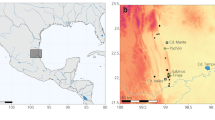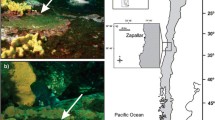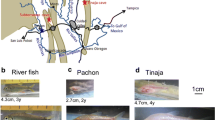Abstract
We studied shoaling behaviour in a species of fish (Garra barreimiae) from Oman. We compared two populations (a surface-dwelling and a cave-dwelling population) with different theoretical costs and benefits of shoaling. We measured the tendency to associate with a shoal of conspecifics. The stimulus shoal was confined to (1) clear Plexiglas cylinders in light, (2) wire-mesh cylinders in light, or (3) wire-mesh cylinders in darkness. The surface form exhibited a strong preference for the stimulus shoal during the experiments in light, but also in darkness, when only non-visual cues from the shoal could be perceived. The cave form did not show a preference when solely visual cues were available (Plexiglas cylinder). When non-visual cues from the shoal could be perceived (wire-mesh), the cave form did show a preference to associate with the shoal, but the shoaling tendency was considerably weaker than in the surface form. The shoaling tendency has probably been genetically reduced in the cave form.

Similar content being viewed by others

References
Ashley AJ, Kats LB, Wolfe JW (1993) Balancing trade-offs between risk and changing shoal size in northern red-belly dace (Phoxinus eos). Copeia 1993:540–542
Banister KE (1984) A subterranean population of Garra barreimiae (Teleostei: Cyprinidae) from Oman, with comments on the concept of regressive evolution. J Nat Hist 18:927–938
Banister KE (1987) Two new species of Garra (Teleostei–Cyprinidae) from the Arabian peninsula. Bull Br Mus Nat Hist Zool 52:59–70
Barber I, Wright HA (2001) How strong are familiarity preferences in shoaling fish? Anim Behav 61:975–979
Barr TC, Holsinger JR (1985) Speciation in cave faunas. Annu Rev Ecol Syst 16:313–337
Berti R, Vezzosi R, Ercolini A (1989) Locomotory response of Phreatichthys andruzzii Vinciguerra (Pisces, Cyprinidae) to chemical signals of conspecifics and of closely related species. Experientia 45:205–207
Brock VE, Riffenburgh RH (1960) Fish schooling: a possible factor in reducing predation. J Conseil 25:307–317
Brown C, Laland KN (2003) Social learning in fishes: a review. Fish Fisheries 4:280–288
Büttiker W, Krupp F (1989) Fauna eines Sandmeeres—Zoologische Untersuchung in der Wahiba—Wüste, Oman. Nat Mus 119:241–261
Chapman MR, Kramer DL (1996) Guarded resources: the effect of intruder number on the tactics and success of defenders and intruders. Anim Behav 52:83–94
Chivers DP, Brown GE, Smith RJF (1995) Familiarity and shoal composition in fathead minnows (Pimephales promelas): implications for antipredator behaviour. Can J Zool 73:955–960
Feulner G (1998) Wadi fish of the UAE. Tribulus 8(2):16–22
Foster SA (1985) Group foraging by a coral reef fish: a mechanism for gaining access to defended resources. Anim Behav 33:779–782
Fowler HW, Steinitz H (1956) Fishes from Cyprus, Iran, Iraq, Israel and Oman. Bull Res Counc Isr 5B:260–292
Godin JGJ (1986) Antipredator function of shoaling in teleost fishes: a selective review. Naturaliste Can 113:241–250
Hager MC, Helfman GS (1991) Safety in numbers—shoal choice by minnows under predatory threat. Behav Ecol Sociobiol 29:271–276
Hassan ES (1989) Hydrodynamic imaging of the surroundings by the lateral line of the blind cave fish Anoptichthys jordani. In: Coombs S, Gorner P, Munz H (eds) The mechanosensory lateral line neurobiology and evolution. Springer, Berlin Heidelberg New York, pp 217–228
van Havre N, FitzGerald GJ (1988) Shoaling and kin recognition in the threespine stickleback (Gasterosteus aculeatus L.). Biol Behav 13:190–201
Hüppop K (1986) Oxygen consumption of Astyanax fasciatus (Characidae, Pisces): a comparison of epigean and hypogean populations. Environ Biol Fish 17:299–308
Hüppop K (1988) Phänomene und Bedeutung der Energieersparnis beim Höhlensalmler Astyanax fasciatus. PhD thesis, University of Hamburg
Hüppop K (2000) How do cave animals cope with the food scarcity in caves? In: Wilkens H, Culver DC, Humphries WF (eds) Ecosystems of the world 30: subterranean ecosystems. Elsevier, Amsterdam, pp 159–188
Jankowska M, Thinès G (1982) Étude comparative de la densité de groupes de poissons cavernicoles et épigés (Characidae, Cyprinidae, Clariidae). Behav Process 7:289–294
Keenleyside MHA (1979) Diversity and adaptation in fish behaviour. Springer, Berlin Heidelberg New York
Krause J (1993) The influence of hunger on shoal size choice by three-spined sticklebacks, Gasterosteus aculeatus. J Fish Biol 43:775–780
Krause J (1994) The influence of food competition and predation risk on size-assortative shoaling in juvenile chub (Leuciscus cephalus). Ethology 96:105–116
Krause J, Ruxton GD (2002) Living in groups. Oxford University Press, Oxford
Krause J, Hartmann N, Pritchard VL (1999) The influence of nutritional state on shoal choice in zebrafish, Danio rerio. Anim Behav 57:771–775
Krupp F, Schneider W (1988) Die Süβwasserfauna des Vorderen Orients. Anpassungsstrategien und Besiedlungsgeschichte einer zoogeographischen Übergangszone. Nat Mus 118(7):193–212
Langecker TG (2000) The effects of continuous darkness on cave ecology and cavernicolous evolution. In: Wilkens H, Culver DC, Humphries WF (eds) Ecosystems of the world 30: subterranean ecosystems. Elsevier, Amsterdam, pp 135–157
Magurran AE (1990) The adaptive significance of schooling as an antipredator defence in fish. Ann Zool Fenn 27:51–66
Magurran AE, Pitcher TJ (1987) Provenance, shoal size and the sociobiology of predator evasion behaviour in minnow shoals. Proc R Soc Lond B 229:439–445
Magurran AE, Seghers BH (1991) Variation in schooling and aggression amongst guppy (Poecilia reticulata) populations in Trinidad. Behaviour 118:214–234
Magurran AE, Oulton W, Pitcher TJ (1985) Vigilant behaviour and shoal size in minnows. Z Tierpsychol 67:167–178
Magurran AE, Seghers BH, Carvalho GR, Shaw PW (1992) Behavioural consequences of an artificial introduction of guppies (Poecilia reticulata) in N. Trinidad: evidence for the evolution of antipredator behaviour in the wild. Proc R Soc Lond B 248:260–277
Magurran AE, Seghers BH, Carvalho GR, Shaw PW (1993) Evolution of adaptive variation in antipredator behaviour. In: Huntingford FA, Torricelli P (eds) Behavioural ecology of fishes. Harwood Academic, Amsterdam, pp 29–44
Montgomery JC, Coombs S, Baker CF (2001) The mechanosensory lateral line system of the hypogean form of Astyanax fasciatus. Environ Biol Fish 62:87–96
Neill SR, Cullen JM (1973) Experiments on whether schooling by their prey affects the hunting behaviour of cephalopods and fish predators. J Zool Lond 172:549–569
Partridge BL, Pitcher TJ (1980) The sensory basis for fish schools: relative roles of lateral line and vision. J Comp Physiol A 135:315–325
Parzefall J (1970) Morphologische Untersuchungen an einer Höhlenform von Mollienesia sphenops (Pisces, Poeciliidae). Z Morph Tiere 68:323–342
Parzefall J (1993a) Behavioural ecology of cave-dwelling fishes. In: Pitcher TJ (ed) Behaviour of teleost fishes, 2nd edn. Chapman and Hall, London, pp 573–608
Parzefall J (1993b) Schooling behaviour in population-hybrids of Astyanax fasciatus and Poecilia mexicana (Pisces, Characidae and Poeciliidae). In: Schröder H, Bauer J, Schartl M (eds) Trends in ichthyology. Blackwell Science, Oxford, pp 297–303
Pitcher TJ, Parrish JK (1993) Functions of shoaling behaviour in teleosts. In: Pitcher TJ (ed) Behaviour of teleost fishes, 2nd edn. Chapman and Hall, London, pp 363–437
Pitcher TJ, Maggurran AE, Winfield I (1982) Fish in larger shoals find food faster. Behav Ecol Sociobiol 10:149–151
Plath M, Parzefall J, Schlupp I (2003a) The role of sexual harassment in cave and surface-dwelling populations of the Atlantic molly, Poecilia mexicana (Poeciliidae, Teleostei). Behav Ecol Sociobiol 54:303–309
Plath M, Wiedemann K, Parzefall J, Schlupp I (2003b) Sex recognition in surface and cave-dwelling male Atlantic mollies Poecilia mexicana (Poeciliidae, Teleostei). Behaviour 140:765–782
Poulson TL (1963) Cave adaptation in amblyopsid fishes. Am Midl Nat 70:257–290
Poulson TL, Lavoie KH (2000) The trophic basis of subterranean ecosystems. In: Wilkens H, Culver DC, Humphries WF (eds) Ecosystems of the world 30: subterranean ecosystems. Elsevier, Amsterdam, pp 231–249
Poulson TL, White WB (1969) The cave environment. Science 165:971–981
Pulliam HR, Caraco T (1984) Living in groups: is there an optimal group size?. In: Krebs JR, Davies NB (eds) Behavioural ecology: an evolutionary approach. Blackwell Scientific, Oxford, pp 122–147
Ranta E, Rita H, Lindström K (1993) Competition versus cooperation: success of individuals foraging alone and in groups. Am Nat 142:42–58
Reebs SG, Saulnier N (1997) The effect of hunger on shoal choice in golden shiners (Pisces: Cyprinidae, Notemigonus crysoleucas). Ethology 103:642–652
Seghers BH (1974) Schooling behaviour in the guppy Poecilia reticulata: an evolutionary response to predation. Evolution 28:486–489
Thinès G, Durand J-P (1973) Connaissances actuelles sur l’appareil sensoriel de la ligne latérale chez des vertébrés cavernicoles aquatiques. Ann Spéléol 28:271–282
Walters LH, Walters VW (1965) Laboratory observations on a cavernicolous poeciliid from Tabasco, Mexico. Copeia 1965:214–233
Weber A (2000) Fish and amphibia. In: Wilkens H, Culver DC, Humphries WF (eds) Ecosystems of the world 30: subterranean ecosystems. Elsevier, Amsterdam, pp 109–132
Weber A, Proudlove GS, Parzefall J, Wilkens H, Nalbant TT (1998) Morphology, systematic diversity, distribution and ecology of stygobitic fishes. In: Juberthie C, Decu V (eds) Encyclopaedia Biospeologica, Tome II. Société de Biospéologie, Moulis-Bucarest, pp 835–1373
Weissenbacher A, Sattmann H, Christ M, Scattolin G, Ahnelt H (2002) Auf der Spur der blinden Höhlenfische. Aquaristik-Fachmagazin 34:66–72
Wilkens H (1988) Evolution and genetics of epigean and cave Astyanax fasciatus (Characidae, Pisces). Support for the neutral mutation theory. Evol Biol 23:271–367
Acknowledgements
The authors would like to thank H. Wilkens for access to his fish stocks. A. Weber and J. Parzefall kindly read an earlier version of this article. Two anonymous reviewers provided valuable comments. We thank T.H. Dirks, I.D. Schmidt, A. Taebel-Hellwig, and the aquarium team in Hamburg for technical assistance and animal care. The experiments presented in this article comply with the current laws in Germany.
Author information
Authors and Affiliations
Corresponding author
Additional information
Communicated by R.F. Oliveira
Rights and permissions
About this article
Cite this article
Timmermann, M., Schlupp, I. & Plath, M. Shoaling behaviour in a surface-dwelling and a cave-dwelling population of a barb Garra barreimiae (Cyprinidae, Teleostei). acta ethol 7, 59–64 (2004). https://doi.org/10.1007/s10211-004-0099-8
Received:
Revised:
Accepted:
Published:
Issue Date:
DOI: https://doi.org/10.1007/s10211-004-0099-8



